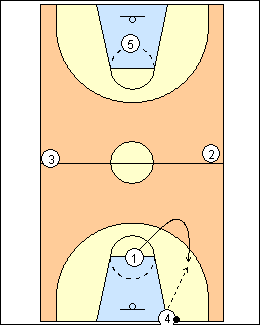Tactics
 | 1 General rules - get the ball out and in fast (Roy Williams) - use crisp air passes - pass the ball up the floor until pressured then reverse it or find the open player - use the whole court and reverse the ball to the other side - be patient, 8 seconds is long enough - think attack, the best way to get the other team to quit pressing is to score a few easy baskets - use a 1-3-1 or 2-1-2 set, and get the ball to the middle. The inbounds passer - get the ball out of the net quickly, run out of bounds with two hands on the ball, don't go out the same side all the time (Roy Williams) - loop to see the floor before stepping out of bounds - use quick (but safe) inbounding to break the press before it gets set - get outside the lane, run the baseline so the pass is vertical not diagonal, use pass fakes - if possible, make a deep inbounds pass to a player in motion (lead the receiver to the elbow) - stay behind the level of the ball until it crosses the centre line, create a passing angle (do not follow the inbounds pass). |
 | 2 The point guard or primary receiver(s) - banana cut to get the ball on the run, not low - create space with a misdirect cut then show target hands on a circle cut back to the ball (for a control pass), or a back cut away from the ball (an attack pass) - if a defender shows chest, take a couple of hard steps into him then back cut (can walk him down to the baseline, seal and release upcourt) - if the defender shows fingertips/forearm, take a couple of hard steps into him then face cut to get in front - swim over a low arm, rip underneath a high arm - if the defender takes away the step-over, spin back the opposite direction - cut back and make a Steve Nash circle cut in front of a defender - post and go to meet the ball with distance from the baseline to work (the further away the better), catch and face upcourt, use the dribble to beat a defender (pick one defender, attack a shoulder) or use a pullback to create space for a pass - get his tail to the ballside sideline, run back if he doesn't get the ball (Roy Williams, Bruce Pearl circle-back move). |
 | 3 Without the ball - go upcourt until your defender stops - avoid three in a row, circle cut away from your defender to create a passing lane - or if a defender is between you and the ball, run right at him then make a 90 degree cut - post up in the open floor, body up to a defender then bounce off to cut for the ball - stretch the defence - spread out on the floor, don't allow one defender to defend two attackers, get wide with butt to the sideline and baseline - if your defender goes to trap, you come back to the ball - always have someone side, middle and back when the ball is on the side (shown), and on each side and in the middle when the ball is in the middle of the court - move to the pass, run through the ball, catch and face upcourt - don't let the defence catch up to the ball after a trap, hit the next open man. |
 | 4 With the ball - pass first, dribble second - don't try to pass off the dribble over the defence - pass by the ears, off the hips, or directly over a defender's head - fake high and pass low, or vice versa - when pressured, establish a good pivot foot, use pass fakes, dribble once to improve a passing angle - keep the dribble alive, especially in trapping areas. Approaching a double team - cross centre only when there is room to pass the ball back - make your last dribble and step to the outside of either defender to create a passing lane - use a pullback dribble, take on the slower trapper, or to create space for a pass - force a double team when you want to, not when they want to - draw the trappers and pass before the trap can be set (shown) - move the ball in the direction opposite of two oncoming trappers. |
 | 5 In a double team - stay low, maintain balance - face the trappers, don't turn your back - pass away from the defence - if near a sideline or endline, bounce the ball out of bounds off a defender - ball fake and split the trap, take the ball low and protect it on the step through (defenders are not knee-to-knee) - step into the middle of one trapper's stance, spin dribble out of the trap then dribble in front to avoid the reach from behind - take an outside leg - take a long step around the outside leg of a trapper and bust out - create a passing angle by reverse pivoting to seal the outside foot of a trapper - if trapped wide on the inbounds pass, pass to the inbounder with a wrap-around pass (shown) - if the trap is high (near the baseline), wrap-around pass to the sideline. |
This page was made with Basketball playbook from Jes-Soft